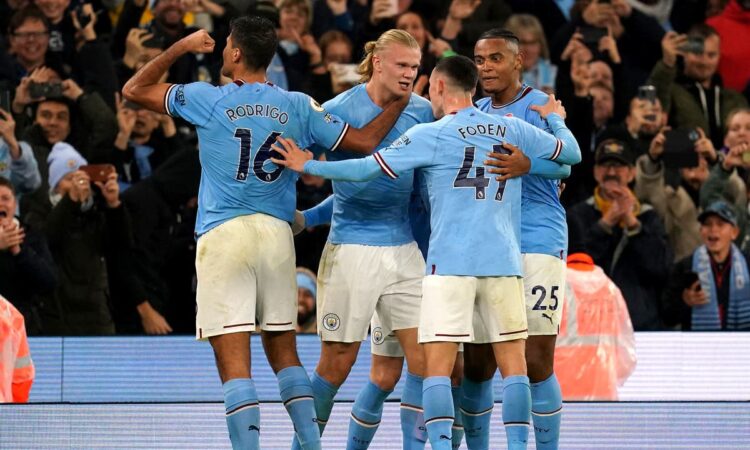
English clubs occupy more than half of the top 20 spots in the Deloitte Football Money League for the first time, with Manchester City retaining pole position.
The Premier League’s dominance of the global club game is underlined in the financial services firm’s 2023 report, which found 11 of the top 20 clubs generating the most revenue in the 2021-22 season were based in England.
The English top flight’s broadcast revenues remain the envy of the rest of the world, and the report found that 16 clubs – 80 per cent of the league – featured in the 2023 Money League’s top 30.
Manchester City generated £619.1million in 2021-22, according to the report, including a Premier League record of almost £330m in commercial revenue.
Liverpool achieved their highest-ever position of third in the survey’s 26-year history with recorded revenue of £594.3m. The Reds were seventh in the previous Money League, but their 2021-22 performance – including a run to the Champions League final – took them above north-west rivals Manchester United for the first time.
Leeds entered the top 20 for the first time since 2002-03, coming in 18th, while Newcastle returned to the top 20 in 20th position. The report found those clubs’ commercial and matchday revenue earnings helped push them above other English clubs in receipt of similar revenue from the Premier League’s TV deals.
European champions Real Madrid remained second, but their bitter rivals Barcelona dropped from fourth to seventh on the back of a 13 per cent fall in broadcast revenue.
The Premier League model is just so appealing to external markets. There is a danger that (the gap) isn’t bridgeable now for the other leagues.
Tim Bridge, Deloitte Sports Business Group
The report found neither club’s revenue has yet recovered to pre-pandemic levels, with both teams still committed to the idea of a European Super League.
The Premier League was the only one of Europe’s ‘Big Five’ leagues to experience an increase in revenue from broadcast sales in its most recent cycle.
Tim Bridge, the head of Deloitte’s Sports Business Group, told the PA news agency he could envisage a position in years to come where all 20 Premier League clubs occupied places in the top 30, and said the report was “a stark message” for the rest of Europe.
“The Premier League model is just so appealing to external markets. There is a danger that (the gap) isn’t bridgeable now for the other leagues,” he said.
“You really need one of those other leagues to take ‘first mover advantage’ around something like new technology or to embrace or embark on a new internationalisation strategy – is there a way for them to go maybe direct to consumer in certain markets via their own app, or via their own production capabilities, and engage with that market and the individuals within it in a way that enables them to leverage all the products and opportunities?
“It’s certainly a big, big challenge.”
The report comes at a time when a Government White Paper on an independent regulator for football is believed to be just weeks away, and amid discussion around a ‘New Deal’ between the football authorities on financial distribution and controls as well as the domestic calendar.
The English Football League is calling for a 25 per cent cut of pooled broadcast revenue with the Premier League.
Bridge added: “If you look at the system overall as it stands today, more money is distributed down the English system than any other. So that will be the Premier League club perspective and point of view – that an awful lot is already is already (being) done.
“There is an argument that redistribution could be positive for the Premier League itself though, because the threat at the moment that’s readily talked about is the idea of the reducing competitive balance in the Championship, and the fact that we’ll just have certain sides that go up and come down.
“Now the Premier League itself would probably want to remove that threat because the product of the Premier League is driven by the diversity and the different clubs that have competed in it at different times.
“It’s an extremely interesting debate and the next few weeks will give us great insight I think into the future direction of English football overall.”






